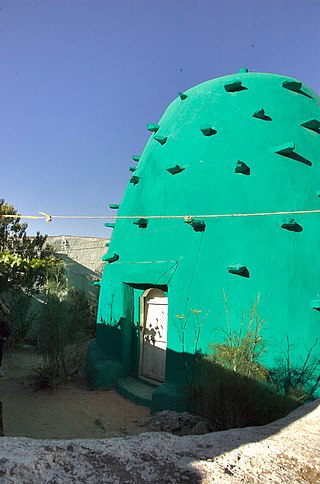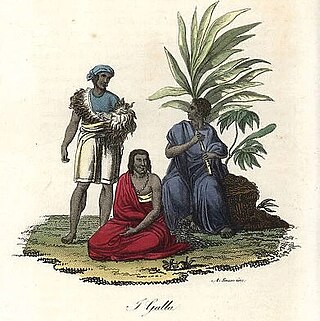Related Research Articles

The Adal Sultanate also known as the Adal Empire, or Bar Saʿad dīn was a medieval Sunni Muslim Empire which was located in the Horn of Africa. It was founded by Sabr ad-Din III on the Harar plateau in Adal after the fall of the Sultanate of Ifat. The kingdom flourished c. 1415 to 1577. At its height, the polity under Sultan Badlay controlled the territory stretching from Cape Guardafui in Somalia to the port city of Suakin in Sudan. The Adal Empire maintained a robust commercial and political relationship with the Ottoman Empire. Sultanate of Adal was alternatively known as the federation of Zeila.

Galawdewos also known as Mar Gelawdewos, was Emperor of Ethiopia from 3 September 1540 until his death in 1559, and a member of the Solomonic dynasty. His throne name was Atsnaph Sagad I. A male line descendant of medieval Amhara kings, he was a younger son of Dawit II and Seble Wongel.

Sarsa Dengel, also known as Sarsa the Great, was Emperor of Ethiopia, and a member of the Solomonic dynasty. His throne name was throne name Malak Sagad I.

The Sultanate of Ifat, known as Wafāt or Awfāt in Arabic texts, or the Kingdom of Zeila was a medieval Sunni Muslim state in the eastern regions of the Horn of Africa between the late 13th century and early 15th century. It was formed in present-day Ethiopia around eastern Shewa in Ifat. Led by the Walashma dynasty, the polity stretched from Zequalla to the port city of Zeila. The kingdom ruled over parts of what are now Ethiopia, Djibouti and Somaliland.
Hadiya also known as Adea or Hadia was a medieval Muslim state in the southern part of its realm located south of Shewa and west of Sharkha. Hadiya was historically a vassal state of the Adal federation and then became a province of Abyssinia in the fourteenth century. In the 1600s Hadiya regained its independence and was led by a Garad. By 1850, Hadiya is placed north-west of lakes Zway and Langano but still between these areas.
The Battle of Gomit or Battle of Egubba was fought in 1445 between the Ethiopian Empire and a powerful Muslim army under the Adal Sultanate. The Ethiopians were led by Emperor Zara Yaqob, while the forces of Adal were led by Sultan Badlay ibn Sa'ad ad-Din. The Ethiopian army was victorious, and Badlay was slain.
Hadiya, also spelled as Hadiyya, is an ethnic group native to Ethiopia in Southern Nations, Nationalities and Peoples' Region who speak the Hadiyyisa language. According to a popular etymology, the name 'Hadiyya," sometimes written in the versions Hadya, Hadea, Hadija, Hadiyo, Hadiyeh, Adea, Adia, means "gift of god" A historical definition of the Hadiya people based on the old Hadiyya Sultanate included a number of Ethiopian ethnic groups currently known by other names. Currently, this historic entity is subdivided into a number of ethnonyms, partly with different languages and cultural affiliations. In his book "A History of the Hadiyya in Southern Ethiopia," Ulrich Braukämper reported that Leemo, Weexo-giira, Sooro, Shaashoogo, Baadawwaachcho, and Libido (Maraqo) Hadiyya subgroups remain a language entity and preserved identity of oneness, the Hadiyya proper. In contrast, Qabeena, Halaaba, Welene and Gedebano, and Silt'e people developed separate ethnic identities. Clans of Hadiya origin in Oromia, Sidama, Wolayta, Gurage, Tigray, and Afar were completely absorbed by these nations. They were initially all inhabitants of a single political entity, a sultanate, which in the four centuries following its break-up in the mid-16th century fragmented into separate ethnic groups.

Nur al-Din or Nur ibn Mujahidibn ‘Ali ibn ‘Abdullah al Dhuhi Suha was a Somali Emir of Harar who ruled the Adal Sultanate. He was known for marrying his uncle's widow, Bati del Wambara, and he also succeeded Imam Ahmad as leader of the Muslim forces fighting Christian Ethiopia.

The Ethiopian–Adal War or Abyssinian–Adal War, also known in Arabic as the "Futuḥ al-Ḥabash", was a military conflict between the Christian Ethiopian Empire and the Muslim Adal Sultanate from 1529 to 1543. The Christian Ethiopian troops consisted of the Amhara, Tigrayans, Tigrinya and Agaw people, and at the closing of the war, supported by a few hundred Portuguese musketmen. Whereas Adal forces were mainly comprised of Harla, Somali, Afar, as well as Arab and Turkish gunmen. Both sides at times would see the Maya mercenaries join their ranks.
The Argobba are an ethnic group inhabiting Ethiopia. A Muslim community, they are spread out through isolated village networks and towns in the north-eastern and eastern parts of the country. Group members have typically been astute traders and merchants, and have adjusted to the economic trends in their area. These factors have led to a decline in usage of the Argobba language. Argobba are considered endangered today due to exogamy and destitution as well as ethnic cleansing by the Abyssinian state over the centuries.

Slavery in Ethiopia existed for centuries, going as far back as 1495 BC and ending in 1942. There are also sources indicating the export of slaves from the Aksumite Empire. The practice formed an integral part of Ethiopian society. Slaves were traditionally drawn from the Nilotic groups inhabiting Ethiopia's southern hinterland and Oromos. War captives were another source of slaves, though the perception, treatment and duties of these prisoners was markedly different. Although religious law banned Christian slave masters from taking part in the slave trade, many Muslim Ethiopian slave traders took part in the Arab slave trade. Slaves usually served as concubines, bodyguards, servants and treasurers.

The Oromo expansions, also known as the Oromo migrations or the Oromo invasions, were a series of expansions in the 16th and 17th centuries by the Oromo. Prior to their great expansion in the 16th century, the Oromo inhabited only the area of what is now modern-day southern Ethiopia and northern Kenya. Over the centuries due to many factors, mostly the wars between Adal Sultanate and Ethiopia would further encourage the numerous Oromo tribes to expand towards central and eastern modern Ethiopia.

Fatagar was a historical province that separated Muslim and Christian dominions in the medieval Horn of Africa. In the eleventh century it was part of the Muslim states, then was invaded by the Christian kingdom led by Emperor Amda Seyon I, after which it would serve as central district in, and home of multiple rulers of, the Ethiopian Empire in the 15th century.
Wej was a province established in the 10th-century and located in the southwest of what is now Ethiopia.
A Malassay was a member of the elite infantry units that formed the Adal Sultanate's household troops. According to Manfred Kropp, Malassay were the Harari armed forces.
The siege of Mukha was fought in 1423 between the Ethiopian Empire and the Adal Empire. Sultan Mansur ad-Din was victorious after a siege lasting two months.
Damot was a historical region located in western Ethiopia. The region was situated south of Gojjam and covered most of Ethiopia's Welega Province. Until the fourteenth century it was ruled by its own independent kingdom, before its conquest by the Ethiopian Emperor Amda Seyon I, after which it would serve as an important province within the Ethiopian Empire during the medieval period.
Muhammad ibn Nasir, reigned 1573–1576, was a sultan of the Sultanate of Adal in the Horn of Africa.
The Battle of Webi River was fought in 1576 between the forces of Adal led by Muhammad ibn Nasir, and the Abyssinian army, under Sarsa Dengel. The outcome of this last war proved to be the end of the political importance of Harar, as the invading Muslim force was liquidated. This major defeat ended the Sultanate of Adal's status as a major military power and permanently ceased its aggression towards Ethiopia.
Abbas ibn Abun ibn Ibrahim better known as Wazir Abbas was an Adalite General who became Grand Vizier of Adal Sultanate in 1535. The nephew of Ahmed Gurey, he lead the Adalite conquest of Medri Bahri and was briefly the Bahr Negash. He was also the father of the Sultan Talha ibn Abbas.
References
- ↑ Hassan, Mohammad (2015). The Oromo and the Christian Kingdom of Ethiopia. Boydell & Brewer. p. 95. ISBN 9781847011176.
- ↑ Pankhurst, Richard (1997). The Ethiopian Borderlands: Essays in Regional History from Ancient Times to the End of the 18th Century. The Red Sea Press. p. 101. ISBN 9780932415196.
- 1 2 3 Pankhurst, Richard (1997). The Ethiopian borderlands : essays in regional history from ancient times to the end of the 18th century. Red Sea Press. p. 188. ISBN 0-932415-19-9. OCLC 36543471.
- ↑ Pankhurst, Richard (1997). The Ethiopian borderlands : essays in regional history from ancient times to the end of the 18th century. Red Sea Press. p. 285. ISBN 0-932415-19-9. OCLC 36543471.
- ↑ Braukämper, Ulrich (2002). Islamic History and Culture in Southern Ethiopia. LIT Verlag Münster. p. 46. ISBN 9783825856717.
- ↑ Tourism Potential in Aurangabad: With Ajanta, Ellora, Daulatabad Fort. Bharatiya Kala Prakashan. 1999. p. 6. ISBN 9788186050446.